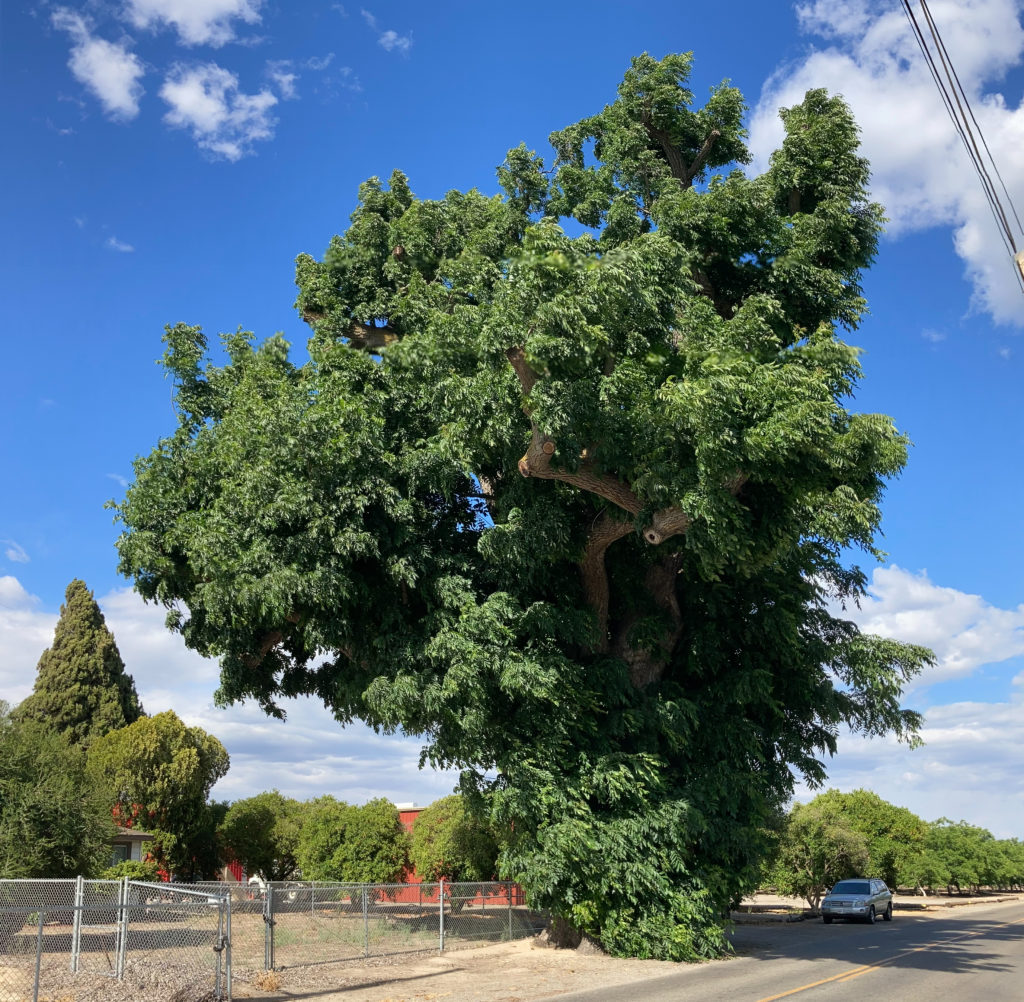
Summer 2021
All hail Mother Vlach
When was the last time you saw a 1904 Ford Model B? How about a 1904 Oldsmobile Runabout? My guess is that unless you live next to a car museum, you haven’t seen one driving down your street lately.
There is a piece of history you can see from 1904 still growing in Stanislaus County. It’s not a car; it’s a tree, and it is one of the oldest Paradox hybrid walnut trees still living.
Planted in 1904 by Jacob Cover on the corner of Dakota and North Avenues in West Modesto, the 117-year-old walnut tree looks its age. The deep dark lines down the large trunk and huge branches that stretch over 50 feet into the sky is one of the largest trees in the county. The seedling Paradox tree was selected in the late 1800s and planted by Jacob Cover, one of the earliest nurserymen in Northern California, on a plot of land owned by Mr. Cover.
Over the years the property was sold to Otis Vlach, and when the seedling Paradox tree survived drought, storms and disease, people started to notice.
One entrepreneurial individual was John Driver. He and his brother Bob Driver lived down the road from the stately Paradox tree on North Avenue. The brothers were the owners of Driver Nursery, and it was John who first took cuttings from the large Paradox tree in 1984 to initiate it into tissue culture and begin propagating it as a viable rootstock for walnuts. John had started Plant Research Laboratories in the ‘80s to clonally propagate walnut rootstocks for nurseries. It was only fitting to call the walnut clone “Vlach” in honor of the Vlach family who lived under the mighty tree.
For years, nurseries relied on the chance pollination of black walnut (Juglans hindsii) with pollen from the English walnut (Juglans regia) to produce a hybrid known as Paradox. The fact that a highly desired offspring would be the result of a cross between a black and an English could teach us all about what we value and how we see others. Nevertheless, not every black walnut seed would be cross pollinated by an English walnut, but when the seed was harvested no one could tell which seed was pollinated and which one was not. It was only after the seed germinated in the nursery row that a keen-eyed grower would recognize the difference between a black walnut seedling and the highly desired Paradox hybrid. At that point the black walnut seedlings were removed and the Paradox hybrid seedlings were left in the nursery row to be grafted to the various English walnut varieties.
As you can imagine, each year could yield a different number of Paradox hybrid seedlings depending on the pollination. There was no way to predict the outcome. People planted English walnut trees around their black walnut trees to increase the chance of creating a Paradox hybrid. Sometimes even English walnut pollen was blown onto a black walnut tree in the hopes of increasing the percentage of Paradox seedlings produced. In the end, it was mostly dependent on chance to yield an acceptable level of Paradox hybrid seedlings.
After years of observing this hybridization that was largely left to chance, the idea came to clonally propagate Paradox hybrid to ensure the results and not leave it up to chance pollination.
So which Paradox hybrid tree do you select to become the mother of walnut rootstocks?
Why not the tree that stood the test of time? Like a stalwart mother who was always there – through the rain and sun, the good times and the hard times – to provide a stable base for her children.
The obvious choice was mother Vlach with her stately structure and never-quit perseverance.
John Driver did just that. He initiated shoots of the Vlach mother tree into tissue culture and began multiplying them. After he rooted them, they were planted in the nursery row yielding 100% Vlach Paradox hybrid rootstock ready to be grafted. No longer was it left to chance to determine the Paradox stand for the year. Now the nursery could count on a steady supply of Paradox rootstocks on which to graft the various varieties. Now when you order your walnut trees on Vlach rootstock, you know the source, and you can thank the Drivers for initiating that first clone.
I am sure that if Mother Vlach tree could talk, she could tell stories of new roads, new houses and new cars driving by since 1904. She could also talk of a legacy leaving thousands of offspring, started from her branches, establishing orchards all over California. The 1904 Ford Model B might not be around, but the legacy of Mother Vlach still endures today.
Photo: Matt Hannon







